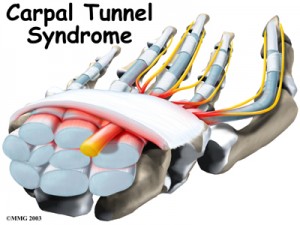What is Carpal Tunnel Syndrome?
Carpal tunnel syndrome occurs when the median nerve which runs from the forearm into the hand becomes pressed or squeezed at the wrist. This results in pain, weakness, or numbness in the hand and wrist, radiating up the arm.
How is it diagnosed?
A physical examination help determine if the syndrome are related to daily activities or to an underlying disorder and can rule out other painful conditions that mimic carpal tunnel syndrome. Electromyography is often used to confirm the diagnosis. This involves a fine needle being inserted into a muscle where electrical activities are viewed on a screen determining the severity of damage to the median nerve. Ultrasound imaging can also show impaired movement of the median nerve.
What are the causes?
Carpal tunnel syndrome is often the result of a combination of factors that increase pressure on the median nerve and tendons in the carpal tunnel, rather than a problem with the nerve itself. Most likely the disorder is due to a congenital predisposition. Other contributing factors include trauma or injury to the wrist that cause swelling, such as sprain or fracture. It can also be caused by medical conditions such as diabetes, arthritis, pregnancy and obesity.
What are the treatments?
Treatments for carpal tunnel syndrome should begin as early as possible under a doctor’s direction. Initial treatment generally involves resting the affected hand and wrist for at least 2 weeks, avoiding activities that may worsen symptoms and immobilizing the wrist in a splint to avoid further damage from twisting or bending. If there is inflammation, applying cool packs can help reduce swelling. Surgery is recommended if symptoms last for more than 6 months. Surgery involves severing the band of tissue around the wrist to reduce pressure on the median nerve.






